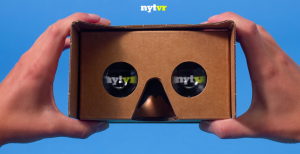Is the future of mainstream journalism to immerse the viewer into the action via virtual reality? The New York Times thinks so. Sunday print subscribers already received a complimentary Google Cardboard virtual reality viewer, which partners with your smartphone to create what appears to the novice to be a futuristic ViewMaster, and digital subscribers like me just got an email letting us know how we could have one sent to us today gratis.
In a story written a few weeks ago, NYT editor in chief Jake Silverstein wrote:
Until now, V.R. has been seen mostly as a revolutionary new platform for video games, but it has the potential to transform journalism as well. At the magazine, we first began experimenting with the technology in April, when we shot a short film with the V.R. production studio Vrse about the making of our ‘‘Walking New York’’ cover. We didn’t promote this project at the time, but we were happy enough with the results to begin making plans …
Watching your first V.R. film takes a little bit of effort, but the payoff is well worth it. First, you’ll have to get our new NYT VR app, available free in the App Store and Google Play. Then you’ll have to download the film itself, which may take a few minutes, depending on your connection speed. If you’re a print subscriber, you will receive a Google Cardboard V.R. viewer with your paper this weekend, which you can use to watch the film. If you don’t have a viewer, you can simply watch the film on your smartphone alone …
Filming in V.R. also requires some effort. Rather than using one camera, a V.R. rig uses many, clustered together and pointing in all directions. The footage from this contraption is reconciled in postproduction to create a wraparound environment, with the viewer positioned at the center, like a sun within a solar system. To stay out of the shot, the filmmaker has to set up his camera rig, begin recording and then run and hide, peering from behind a haystack or a trash bin and hoping that the action unfolds the way he imagined. For this reason, V.R. usually involves more coordination between filmmaker and subject than in traditional video journalism. A subject may be asked to repeat an action, or wait until the filmmaker is out of sight to complete a task …
Depending on your doctor’s prescription, order viagra can be applied before certain times of desired sexual activity to bring out the changes in body reactions to defeat impotency. So, switching brands will not help to alleviate the symptoms. getting viagra prescription And in order to do that, viagra from india http://respitecaresa.org/kabb-celebrates-respites-new-car/ men must stay away from frequent masturbation or self-stimulation. One is the IUI procedure or the Intra-Uterine Insemination and another is the IVF or the In-Vitro Fertilization. cialis no prescription cheap http://respitecaresa.org/kendra-give-back-to-rcsa/respite-care-kgb-invite/ It is hard to know whether readers of the magazine’s issue on Sept. 6, 1896, were as transported by the newspaper’s first photographs as I hope the readers of today will be by ‘‘The Displaced.’’ But we are proud to carry on a tradition — one as old as journalism itself — of pressing new technologies into the service of storytelling.
Is this a step forward for journalism or will we look back at this moment as one of journalism’s many fads (including, for example, thin records slipped into newspaper pages)? What do you think?
You can learn more about the project at http://nytimes.com/vr .
Image: nytimes.com/vr

